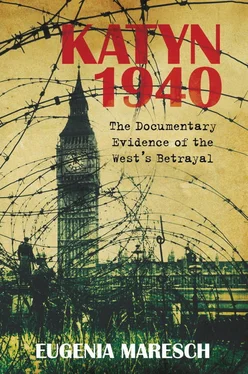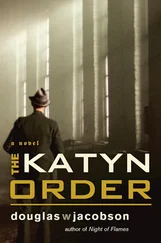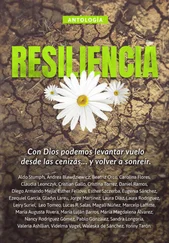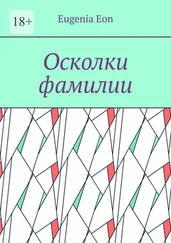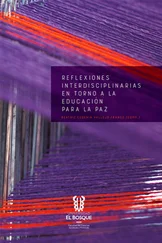My role on this day was confined to that of a silent observer. I noticed then that the members of the Commission, after a detailed examination of the clothes, conducted a very detailed examination of the bodies and dissections of them and dictated reports immediately, on the spot, to the military typists. They also examined the general layout of the bodies in the graves and examined individual bodies in situ. The Commission finished its work at Katyn at about 1 pm and afterwards went to the NKVD dacha on the river. In the early hours of the afternoon, the Commission departed in the direction of Smolensk.
Professor Orsós of Budapest showed the greatest interest among the members of the Commission. For a long time, he conducted a detailed dissection and took away material (a skull) with a view to further examination to determine the length of time the body had lain in the ground. This he could fix by the number of layers of calcium on the inner side of the bones of the skull. Professor Orsós demonstrated on a sawn off skull the presence of two layers of calcium which, according to him, proved that the body had lain more than two years in the earth. Having closely watched the dissection conducted by him, I subsequently approached him personally and had a short conversation with him.
Professor [Francisek] Hajek of Prague was especially friendly towards Professor Buhtz and also showed particular interest in the diary he found on the body he was dissecting. I personally had the closest contact with Professor [Francisek] Subik, a Slovak, who in private conversation with me stressed his inimical feelings towards the Germans and sharply criticised the quisling government of Tito, declaring at the same time that he had no doubt that the crime of Katyn had been perpetrated by the Soviets. Dr [Marko] Markov, the Bulgarian of Sophia University Forensic Medicine also showed a considerable interest. He personally conducted the dissection of a body and dictated in German a report on the examination and dissection. The Rumanian dictated his report on the dissection that he made with the aid of an interpreter, because he did not know German well. The Italian Professor [Vincensio] Palmieri also conducted a dissection personally and made a detailed examination of a body. The Finn [Dr Arno Saxen] did not dissect but watched closely Professor Orsós while he performed his dissection. The only genuinely neutral member of the Committee was a Swiss Professor [Francois] Naville from Geneva. He did not personally conduct a dissection but watched the other members of the Committee. But he examined the undergrowth in the vicinity of the graves, looking for cartridges and examined closely the trees near the graves, searching probably for traces of embedded bullets.
I noticed that the approach of the German Prof Buhtz, his assistant OLt [Gregor] Slovenzik, Dr Schmidt, and others, to the members of the Committee of Experts was extremely courteous. Dr Schmidt in particular offered drinks during their work. It should be said that it was a chilly day and the experts had removed their coats while working. I did not see the signing of the medico-legal statement by members of the Committee and only knew of its contents later from the German press, published in the Russian language.
Five Weeks of Work in Katyn Woods
I worked at Katyn from 1 May to 3 June 1943. To half way through May, I lived with the Technical Commission members in a wooden barrack assigned to us by the Germans in the grounds of an advance hospital unit of the Organisation Todt in the village of Borok, about 3 kilometres South-West of the Katyn woods. [Before the 1914–18 War the whole estate belonged to a Polish landowner – the Koźliński family – it was confiscated after the Revolution.] In the second half of May, we were transferred to a four-room house, about 1½ kilometres to the north of the Orsha-Smolensk main road, situated in the vicinity of the Katyn railway station. In the beginning, we were not satisfied with this transfer, because we had farther to go to work but afterwards we were glad to be thus separated from the Germans.
At first, we ate our meals, breakfast, lunch and dinner, in the hospital staff mess at Borok village, afterwards on our transfer to the house allocated to us for this purpose, a Russian woman who was working on the staff of the hospital brought our meals to our quarters. I assumed this change of living quarters and separate meals to mean that the Germans did not like us having the opportunity of getting in touch with members of the Organisation Todt (amongst whom there were Poles), who more than once did not conceal their dissatisfaction with the conditions under which they were working.
During the period of our stay, we continually felt that we were subjected to silent German observation, but with regard to this we were never restricted or hampered in our work. Every member of the Technical Commission was supplied with Red Cross armbands, with the result that according to general instructions given by the German authorities, we were able to use military lorries, which occasionally passed along the main road to take us from our living quarters to our place of work. Sometimes we had to wait an hour, which interfered with the regularity of our work. Sometimes we had to walk. In principle, work went on from 8 to 12 in the morning and from 2 to 5 or 6 in the afternoon; during the lunch interval we either drove or went on foot to our quarters.
On the Smolensk-Orsha main road, in the vicinity of the road leading to Katyn woods, were German Military Police posts, they were on duty during the whole of my stay at Katyn and were not only directing the traffic on the road but also preventing unauthorised persons, those who were not working there or were not members of visiting parties, entering the area. At the entrance of the road to the woods leading from the main road was a barrier and the visiting parties were assembled on the other side of the road from where they were conducted by the German guide. Near the barrier there were two notices signed by Leutnant Voss of the Geheimfeldpolitzei declaring: ‘Entrance to Katyn woods is absolutely forbidden except to those working therein’ and ‘It is absolutely forbidden to take photographs of the scene of the crime.’
From the main road and along two sides of Katyn road, the woods were fenced off with barbed wire. Apart from the posts at the beginning of the main road, I did not see any other permanent German police posts. Local inhabitants were not recruited into the so-called ‘Polish’ or ‘Russian’ auxiliary police. However, I heard from the Poles in Organisation Todt that before my arrival at Katyn and the arrival of other delegations, some dozens of Poles were given caps with the eagle emblem on them and acted at that time as guards in the forest. They were called ‘special Polish police’.
Being the only Polish doctor on the staff of the PCK Technical Commission, I was naturally interested in and took part in all the work being conducted. Despite some German obstruction, I tried as far as possible to develop a proper system of work. Of course my orders concerned only members of my committee. As for the Germans, they stopped the work several times for propaganda purposes, especially at reburial in new communal graves after examination. In general, the Germans were not obstructive, leaving the Technical Commission considerable freedom and limiting themselves to the supervision of our heavy and extremely unpleasant work.
The Germans
At the beginning, I did not see any German doctors undertaking examination or dissection. Only much later, in the second half of May, on the orders of Professor Buhtz, the German Doctors Schmidt, Müller and Hüber carried out several examinations of the bodies. I had the impression that they carried out their work thoroughly, without thinking of its propaganda nature. At any rate I did not notice any propaganda activity on their part. For several weeks towards the end, a lecturer in chemistry named Specht from a German university worked at Katyn. He made a detailed chemical analysis and in particular measured the acidity of samples of earth taken from different layers in the graves and in the vicinity. From this research, it was discovered that the upper layers showed a slight alkaline content but the earth gave a decidedly acid reaction on the deeper layers. Besides this, Dr Specht was interested in all the work at Katyn and took many photographs of the area of exhumation. As with the other German doctors, Dr Specht’s attitude to us was courteous. He communicated to me personally the results of his research. Also working at Katyn was a German geologist, Dr Themlitz, who was especially interested in research on the consistency of the layers of earth in the individual graves.
Читать дальше
